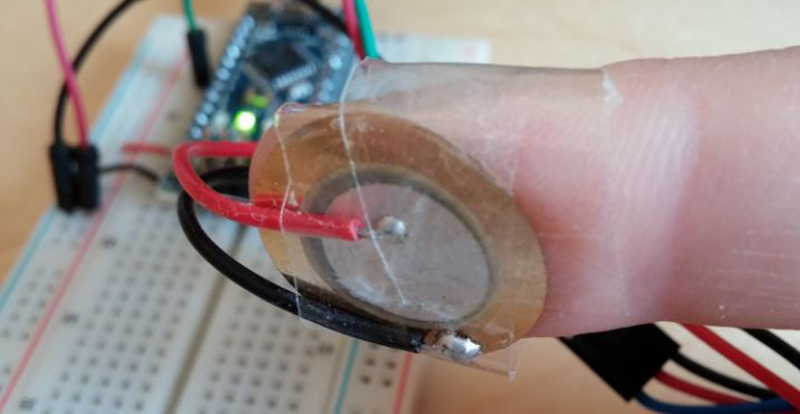Look around for heart rate sensors that interface easily to microcontrollers, and you’ll come up with a few projects that use LEDs and other microcontrollers to do the dirty work of filtering out pulses in a wash of light.
[Thomas] was working on a project that detects if water is flowing through a pipe with a few piezoelectric sensors. Out of curiosity, he taped the sensor to his finger, and to everyone’s surprise, the values his microcontroller were spitting out were an extremely noise-free version of his heart rate.
The piezo in question is a standard, off the shelf module, and adding this to a microcontroller is as easy as putting the piezo on an analog pin. From there, it’s just averaging measurements and extracting a heartbeat from the data.
It’s a much simpler solution to measuring a heart rate, and since two people haven’t heard of this technique, it’s likely a lot more people haven’t heard of this technique either. If you’re looking for an entry to The Hackaday Prize, this would be a great jumping off point for anything in either the fitness or medical domains.
















Cool project, but definitely well known:
http://www.cinc.org/archives/2013/pdf/0671.pdf
http://www.google.com/patents/US20140128753
http://www.mdtmag.com/articles/2008/03/piezo-solution-vital-signs-monitoring
http://www.ncbi.nlm.nih.gov/pubmed/21096461
Actually, the old IVAC model# 4200 Non-Invasive Blood Pressure monitors used this technique to detect the pulse. There was a small microphone in the hose assembly that went into a pocket on the air bladder that was used to look for the pulse. When the cable was damaged, it would stop detecting the pulse and couldn’t take a blood pressure anymore. Modern NIBP monitors sense the change in air pressure and don’t use this technique anymore from what I have seen, but as [Thomas] discovered it was a very simple and effective method to detect the pulse!
For me it is new, I will try it.
Do i have to look out for some special kind of piezo or can I take the 10pcs for 3$ ones from Ebay?
I use these and a scope to check ultrasonic cleaners that I mend for a company. You just need to stick it on the water or even near to the water for it to develop a very readable signal.
How sensitive? I have an application where I would like to make something for an infant to wear that monitors for tachycardia and when it detects it, sends a signal over wifi. It would not have to be hugely accurate, I just need to see when a heart rate exceeds a safe limit like say 140bpm. Would that be possible with a bracelet or anklet thats not overly tight. i.e. would it make enough contact do you think?
Maybe the rather new technique called Eulerian Video Amplification would be a better solution for that. It greatly enhances/amplified minute movements and/or color shifts caused by breathing and the pumping blood. https://youtu.be/ONZcjs1Pjmk?t=1m52s
There are even apps for iphones/android devices that works pretty well, I can just point my phone camera to cover the torso and face and it will show me my current breathing rate and pulse.
Could you link to some of these apps here? I’m interested in this on Android
What do the step-recovery diode and 1M resistor do for the signal – damp excessive oscillation? (from the piezo vendor’s data sheet – .pdf: http://www.dfrobot.com/image/data/DFR0052/Vibration%20Sensor%20SCH.pdf )
If you hit piezo-element strong or fast enough, it can generate few hundreds of volts, this is to stop it from frying your ADC input.
Hmmm. When I’m on the treadmill I’d like to keep an accurate read on my pulse…would this work in a non-quiet situation?
the problem I see is that you should not move during pulse measurement and any external sound/noise/vibration will alter the results
I tried this last night using the piezo element from a smoke alarm. I didn’t even have to take it out of the plastic casing the manufacturer put around it. Just unsolder from the board and hook up to the G and M terminals.
There’s a good bit of noise (60Hz), so some kind of filtering would be a good thing. If the filtering was done really well, band-passing about 1Hz to 3Hz, it would be very effective.